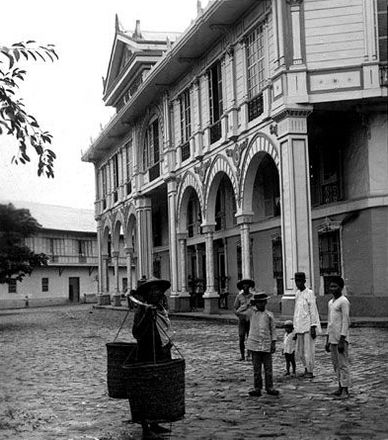Fabulous Philippines > Manila > Chinatown, Manila
Chinatown
Manila
Share this page:
Manila has a large Chinatown which is located on the northern bank of the Pasig River and comprises parts of Binondo and Santa Cruz. The main street, Ongpin Street, runs between the Binondo Church and the Santa Cruz Church. Often Manila's Chinatown is referred to simply as Binondo.

Welcome sign in English and Chinese to Binondo/Chinatown, Manila
Chinatown has three Chinese-style friendship arches. Under the Chinese calligraphy of the signs hanging above its narrow streets you will see a lively area of small apartments and typical Chinese businesses -- tea shops and restaurants, herbalists and apothaceries, gold and jade stores, and more.
And in Chinatown, you will also see calesas (horse-drawn carriages) which are still used in this area instead of taxis and which clip-clop on their way with their passengers.
Chinatown occupies an area of around 1 square kilometer but over the centuries this has been an important business area with a power and influence that belies its small area.
Some of the key places in Manila's Chinatown include the Plaza San Lorenzo Ruiz, the Binondo Church, and the street known as Escolta (which used to be known as the Wall Street of the Philippines).

The Hotel del Oriente (left) and La Insular Cigar and Cigarette Factory (right), both facing the Plaza Carlos IV (now Plaza San Lorenzo Ruiz), in Binondo/Chinatown, Manila in the 19th century.
History
The first Chinese arrived in the Binondo area of Manila in 1594, which has led to this area being dubbed as the "oldest Chinatown in the world".
In that year the Spanish Governor of the Philippines, Luiz Perez Dasmariñas, permitted Chinese immigrants who had converted to Catholicism (a group called sangleys by the Spanish) to settle in Binondo. The Governor gave the Chinese a land grant and limited self-governing privileges.
Interestingly, Binondo was not the first place in Manila where Chinese had lived. Chinese merchants were already present when the Spanish occupied the Manila area in 1571. Due to a number of Chinese uprisings against Spanish rule in Manila in the early days of Spanish Manila, the Chinese were forced to live in an area known as Parian (that is, the area now occupied by Lawton and Arroceros Forest Park to the northeast of Intramuros). Parian was within easy artillery range from the walls of Intramuros. Thus the Spanish rulers believed that compelling the Chinese to live there would prevent any further uprisings.
As time passed, more and more Chinese were converted to Catholicism and many intermarried with indigenous Filipino women. This trend was hastened by several factors: (a) lack of Chinese females for Chinese merchants to marry; (b) violence and often expulsion of those Chinese who refused to convert; (c) tax advantages for Chinese who became Catholics; and (d) intensive evangelization campaigns by Spanish Dominican fathers based in Binondo.
The children of these unions were known as mestizos de sangleyes (Chinese mestizos).

The Hotel del Oriente, Manila's first hotel, in the 19th century.
Businesses in Chinatown over the Years
Chinese merchants were attracted to live in the Philippines and in particular in Manila's Chinatown by the money to be made in the Manila-Acapulco trade and in the inter-island trade (that is, trade between the various islands of the Philippines) developing now that all of the islands of the Philippine archipelago were under the unifying rule of the Spanish.
Chinatown also became an area with many Chinese artisans (for example, ______) and with Chinese manufacturing (for example, in the fields of cigars and bells).
By the late 19th century Chinatown had become the center of business activity for all of Manila. This economic activity involved ethnic Chinese (including the sangleys), the Chinese mestizos (mestizos de sangleyes), and Spanish born in the Philippines.
Some well-known business enterprises included: La Insula ___, Metropolitan ___, and the Hotel del Oriente, all of which were clustered around the Plaza del Binondo (later to be known as the Plaza Carlos IV, the Plaza Calderon de la Barca, and finally the Plaza San Lorenzo Ruiz).
In the 1880s and the 1890s many Chinese-owned general stores (known in Spanish as bazars) operated in Chinatown, offering _______.
In the 20th century right up until World War II, Manila's Chinatown (Binondo) was the center for banking and for finance and insurance companies in the Philippines. These included many foreign-owned enterprises. Banks and the Manila Stock Exchange were located on Escolta Street (Spanish, Calle de la Escolta).
Chinatown was bombed in the Battle of Manila (1945) and many buildings were destroyed, either partially or totally. Most of these were not rebuilt after the war. These included La Insula ____ and the Hotel del Oriente. However, a few important buildings were rebuilt (for example, the Binondo Church).
From the 1960s onwards, many of the important financial and business enterprises transferred their operations either to Ayala-developed Makati or to Cubao (in Quezon City).
In 2005 the Manila city government redeveloped Plaza San Lorenzo Ruiz, which had become very rundown (for example, the fountains had no water).
Share this page:
Author: David Paul Wagner
(David Paul Wagner on Google+)
|